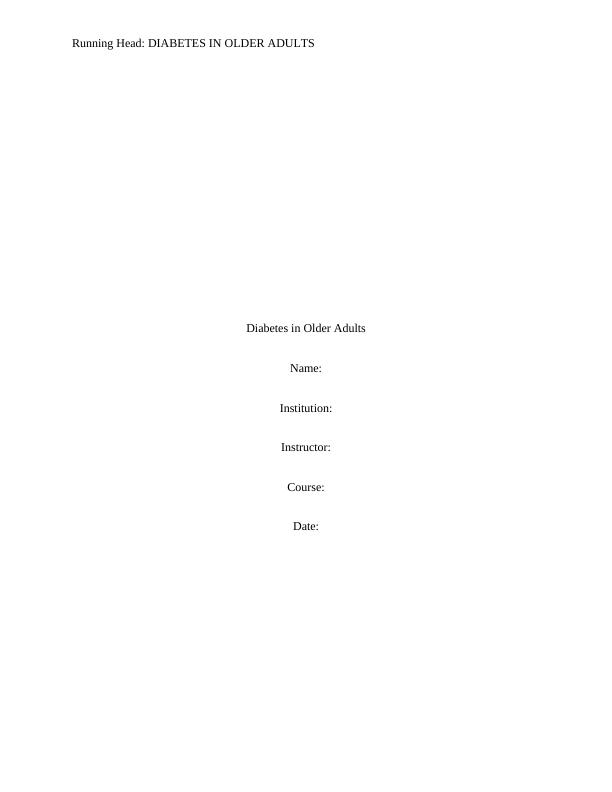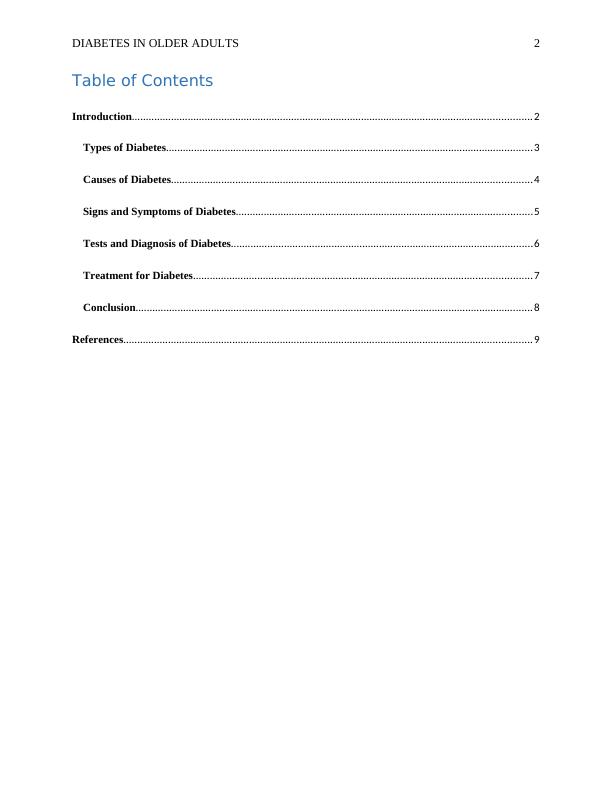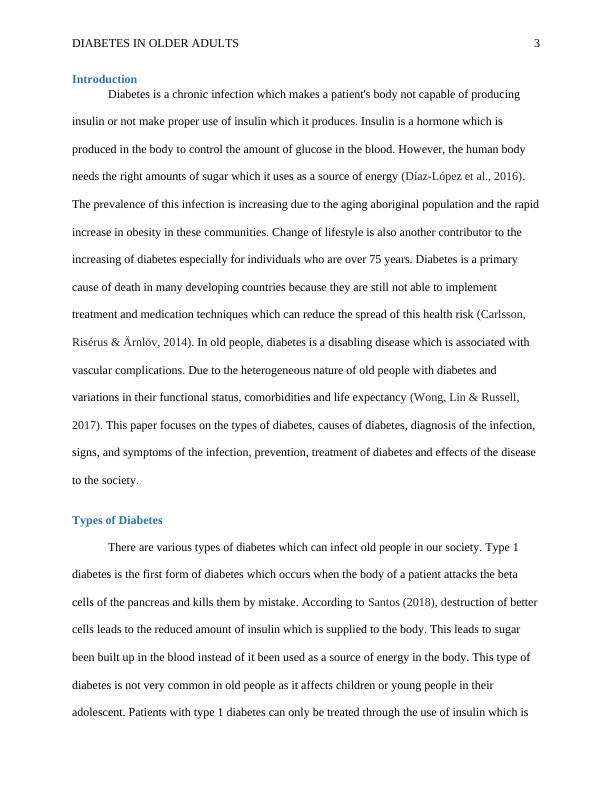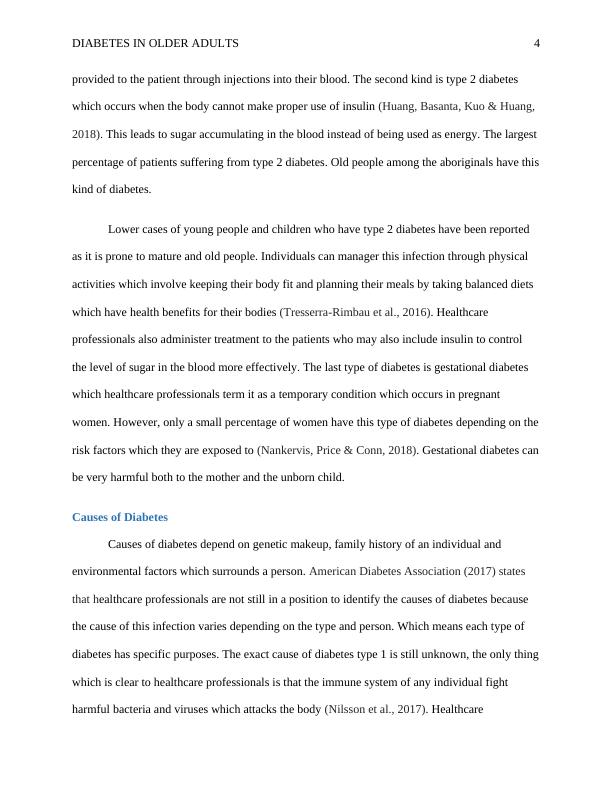Diabetes in Older Adults: Types, Causes, Symptoms, Diagnosis, and Treatment
Added on 2023-06-07
12 Pages3370 Words149 Views
Running Head: DIABETES IN OLDER ADULTS
Diabetes in Older Adults
Name:
Institution:
Instructor:
Course:
Date:
Diabetes in Older Adults
Name:
Institution:
Instructor:
Course:
Date:

DIABETES IN OLDER ADULTS 2
Table of Contents
Introduction...............................................................................................................................................2
Types of Diabetes...................................................................................................................................3
Causes of Diabetes.................................................................................................................................4
Signs and Symptoms of Diabetes..........................................................................................................5
Tests and Diagnosis of Diabetes............................................................................................................6
Treatment for Diabetes.........................................................................................................................7
Conclusion..............................................................................................................................................8
References..................................................................................................................................................9
Table of Contents
Introduction...............................................................................................................................................2
Types of Diabetes...................................................................................................................................3
Causes of Diabetes.................................................................................................................................4
Signs and Symptoms of Diabetes..........................................................................................................5
Tests and Diagnosis of Diabetes............................................................................................................6
Treatment for Diabetes.........................................................................................................................7
Conclusion..............................................................................................................................................8
References..................................................................................................................................................9

DIABETES IN OLDER ADULTS 3
Introduction
Diabetes is a chronic infection which makes a patient's body not capable of producing
insulin or not make proper use of insulin which it produces. Insulin is a hormone which is
produced in the body to control the amount of glucose in the blood. However, the human body
needs the right amounts of sugar which it uses as a source of energy (Díaz-López et al., 2016).
The prevalence of this infection is increasing due to the aging aboriginal population and the rapid
increase in obesity in these communities. Change of lifestyle is also another contributor to the
increasing of diabetes especially for individuals who are over 75 years. Diabetes is a primary
cause of death in many developing countries because they are still not able to implement
treatment and medication techniques which can reduce the spread of this health risk (Carlsson,
Risérus & Ärnlöv, 2014). In old people, diabetes is a disabling disease which is associated with
vascular complications. Due to the heterogeneous nature of old people with diabetes and
variations in their functional status, comorbidities and life expectancy (Wong, Lin & Russell,
2017). This paper focuses on the types of diabetes, causes of diabetes, diagnosis of the infection,
signs, and symptoms of the infection, prevention, treatment of diabetes and effects of the disease
to the society.
Types of Diabetes
There are various types of diabetes which can infect old people in our society. Type 1
diabetes is the first form of diabetes which occurs when the body of a patient attacks the beta
cells of the pancreas and kills them by mistake. According to Santos (2018), destruction of better
cells leads to the reduced amount of insulin which is supplied to the body. This leads to sugar
been built up in the blood instead of it been used as a source of energy in the body. This type of
diabetes is not very common in old people as it affects children or young people in their
adolescent. Patients with type 1 diabetes can only be treated through the use of insulin which is
Introduction
Diabetes is a chronic infection which makes a patient's body not capable of producing
insulin or not make proper use of insulin which it produces. Insulin is a hormone which is
produced in the body to control the amount of glucose in the blood. However, the human body
needs the right amounts of sugar which it uses as a source of energy (Díaz-López et al., 2016).
The prevalence of this infection is increasing due to the aging aboriginal population and the rapid
increase in obesity in these communities. Change of lifestyle is also another contributor to the
increasing of diabetes especially for individuals who are over 75 years. Diabetes is a primary
cause of death in many developing countries because they are still not able to implement
treatment and medication techniques which can reduce the spread of this health risk (Carlsson,
Risérus & Ärnlöv, 2014). In old people, diabetes is a disabling disease which is associated with
vascular complications. Due to the heterogeneous nature of old people with diabetes and
variations in their functional status, comorbidities and life expectancy (Wong, Lin & Russell,
2017). This paper focuses on the types of diabetes, causes of diabetes, diagnosis of the infection,
signs, and symptoms of the infection, prevention, treatment of diabetes and effects of the disease
to the society.
Types of Diabetes
There are various types of diabetes which can infect old people in our society. Type 1
diabetes is the first form of diabetes which occurs when the body of a patient attacks the beta
cells of the pancreas and kills them by mistake. According to Santos (2018), destruction of better
cells leads to the reduced amount of insulin which is supplied to the body. This leads to sugar
been built up in the blood instead of it been used as a source of energy in the body. This type of
diabetes is not very common in old people as it affects children or young people in their
adolescent. Patients with type 1 diabetes can only be treated through the use of insulin which is

DIABETES IN OLDER ADULTS 4
provided to the patient through injections into their blood. The second kind is type 2 diabetes
which occurs when the body cannot make proper use of insulin (Huang, Basanta, Kuo & Huang,
2018). This leads to sugar accumulating in the blood instead of being used as energy. The largest
percentage of patients suffering from type 2 diabetes. Old people among the aboriginals have this
kind of diabetes.
Lower cases of young people and children who have type 2 diabetes have been reported
as it is prone to mature and old people. Individuals can manager this infection through physical
activities which involve keeping their body fit and planning their meals by taking balanced diets
which have health benefits for their bodies (Tresserra-Rimbau et al., 2016). Healthcare
professionals also administer treatment to the patients who may also include insulin to control
the level of sugar in the blood more effectively. The last type of diabetes is gestational diabetes
which healthcare professionals term it as a temporary condition which occurs in pregnant
women. However, only a small percentage of women have this type of diabetes depending on the
risk factors which they are exposed to (Nankervis, Price & Conn, 2018). Gestational diabetes can
be very harmful both to the mother and the unborn child.
Causes of Diabetes
Causes of diabetes depend on genetic makeup, family history of an individual and
environmental factors which surrounds a person. American Diabetes Association (2017) states
that healthcare professionals are not still in a position to identify the causes of diabetes because
the cause of this infection varies depending on the type and person. Which means each type of
diabetes has specific purposes. The exact cause of diabetes type 1 is still unknown, the only thing
which is clear to healthcare professionals is that the immune system of any individual fight
harmful bacteria and viruses which attacks the body (Nilsson et al., 2017). Healthcare
provided to the patient through injections into their blood. The second kind is type 2 diabetes
which occurs when the body cannot make proper use of insulin (Huang, Basanta, Kuo & Huang,
2018). This leads to sugar accumulating in the blood instead of being used as energy. The largest
percentage of patients suffering from type 2 diabetes. Old people among the aboriginals have this
kind of diabetes.
Lower cases of young people and children who have type 2 diabetes have been reported
as it is prone to mature and old people. Individuals can manager this infection through physical
activities which involve keeping their body fit and planning their meals by taking balanced diets
which have health benefits for their bodies (Tresserra-Rimbau et al., 2016). Healthcare
professionals also administer treatment to the patients who may also include insulin to control
the level of sugar in the blood more effectively. The last type of diabetes is gestational diabetes
which healthcare professionals term it as a temporary condition which occurs in pregnant
women. However, only a small percentage of women have this type of diabetes depending on the
risk factors which they are exposed to (Nankervis, Price & Conn, 2018). Gestational diabetes can
be very harmful both to the mother and the unborn child.
Causes of Diabetes
Causes of diabetes depend on genetic makeup, family history of an individual and
environmental factors which surrounds a person. American Diabetes Association (2017) states
that healthcare professionals are not still in a position to identify the causes of diabetes because
the cause of this infection varies depending on the type and person. Which means each type of
diabetes has specific purposes. The exact cause of diabetes type 1 is still unknown, the only thing
which is clear to healthcare professionals is that the immune system of any individual fight
harmful bacteria and viruses which attacks the body (Nilsson et al., 2017). Healthcare

End of preview
Want to access all the pages? Upload your documents or become a member.
Related Documents
Understanding Diabetes Care: Causes, Diagnosis, Treatment and Complicationslg...
|6
|1512
|68
Diabetes Type 2: Mechanism, Signs, Symptoms, Diagnosis, and Treatmentlg...
|11
|946
|80
Diabetes Type 2: Mechanism, Signs, Symptoms, Diagnosis, and Treatmentlg...
|16
|1290
|58
Diabetic Case Scenario: Pathophysiology, Causes, and Nursing Managementlg...
|9
|2775
|91
Understanding Health: Type 2 Diabetes and Australian Healthcare Serviceslg...
|8
|1249
|62
Understanding Type II Diabetes: Symptoms, Treatment and Preventionlg...
|9
|2805
|325
